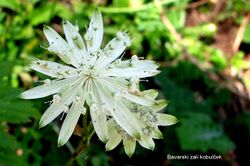Biology:Astrantia bavarica
| Astrantia bavarica | |
|---|---|

| |
| Scientific classification | |
| Kingdom: | Plantae |
| Clade: | Tracheophytes |
| Clade: | Angiosperms |
| Clade: | Eudicots |
| Clade: | Asterids |
| Order: | Apiales |
| Family: | Apiaceae |
| Genus: | Astrantia |
| Species: | A. bavarica
|
| Binomial name | |
| Astrantia bavarica | |
| Synonyms[1] | |
| |
Astrantia bavarica, common name masterwort, is a species of flowering plant in the family Apiaceae, native to Eastern alps.[1] Growing to 30 cm (12 in) tall by 30 cm (12 in) broad, it is an herbaceous perennial, much used in gardens.
Etymology
The specific epithet bavarica, meaning "from bavaria".[2] Bavaria is a state in Germany , which geographically distinguishes this species from its smaller relative Astrantia minor and from its larger relatives Astrantia major and Astrantia maxima. Astrantia bavarica was described by Friedrich Wilhelm Schultz in 1858,[3] and published in Flora Vol.41 (issue 11) on page 161.[4]
Description
Astrantia bavarica reaches on average 30 centimetres (12 in) of height. The stem is erect and glabrous, with little branches and few leaves. The basal leaves have a long petiole 10–20 centimetres (3.9–7.9 in), 3 to 7 lobes and toothed segments. Size: 8–15 centimetres (3.1–5.9 in). The cauline leaves are generally two, sessile, amplexicaul and lanceolate-shaped with a trilobed apex. The inflorescence is umbrella-shaped, with 2–3 centimetres (0.79–1.18 in) of diameter. The floral bracts are numerous (10 - 20), 10–18 millimetres (0.39–0.71 in) long, greenish-white with acuminate apex. The small flowers are greenish-white (with pink undertones). The central ones are hermaphrodite, while the external ones are male. The flowering period extends from April through to November. It has a RHS Hardiness Rating: H7.[5]
Reproduction
Astrantia bavarica is an entomophilous plant, mainly pollinated by beetles, but also by other insects. This perennial plant reproduces itself also by means of buds present at the ground level. It can also be grown from seed as well.
Distribution and habitat
Astrantia bavarica is native to Europe,[4] and found within Germany,[4] Italy, Austria, Slovenia,[6] and the eastern Alps. They are common in mountain woodlands and scrubland, clearings and close to the streams, usually on calcareous soils, at an altitude of 2,300 metres (7,500 ft) above sea level.[7]
References
- ↑ 1.0 1.1 1.2 "Astrantia bavarica L..". Plants of the World Online. Royal Botanic Gardens, Kew. https://powo.science.kew.org/taxon/urn:lsid:ipni.org:names:838311-1.
- ↑ Stearn, William (1972). A Gardenerer's Dictionary of Plant Names. London: Cassell. p. 56. ISBN 0304937215.
- ↑ Hand, Ralf (2011). "Apiaceae". bgbm.org. http://ww2.bgbm.org/EuroPlusMed/PTaxonDetail.asp?NameCache=Astrantia%20bavarica&PTRefFk=7500000.
- ↑ 4.0 4.1 4.2 "Apiaceae Astrantia bavarica F.W.Schultz". ipni.org (International Plant Names Index). http://www.ipni.org/ipni/idPlantNameSearch.do?id=838311-1.
- ↑ "Astrantia bavarica". cgf.net (Cotsworld Graden Flowers). 2001. http://www.cgf.net/plants.aspx?genus=ASTRANTIA.
- ↑ Cardy, Paul (6–14 July 2013). "The Julian and Karawanken Alps". greentours.co.uk. p. 18. http://www.greentours.co.uk/doc/Trip%20Report%20Slovenia%202013%20edited.pdf.
- ↑ "Astrantia bavarica". alpinegardensociety.net. 2011. http://encyclopaedia.alpinegardensociety.net/plants/Astrantia/bavarica.
- Walter Erhardt, Erich Götz, Nils Bödeker, Siegmund Seybold: Der große Zander. Eugen Ulmer KG, Stuttgart 2008, ISBN:978-3-8001-5406-7. (Ger.)
- Christoper Brickell (Editor-in-chief): RHS A-Z Encyclopedia of Garden Plants. Third edition. Dorling Kindersley, London 2003, ISBN:0-7513-3738-2.
External links
- Astrantia bavarica F.W.Schultz | Plants of the World Online | Kew Science
- Astrantia bavarica F. W. Schultz - Encyclopedia of Life
Wikidata ☰ Q15263758 entry
 |


